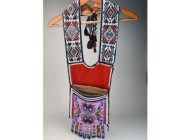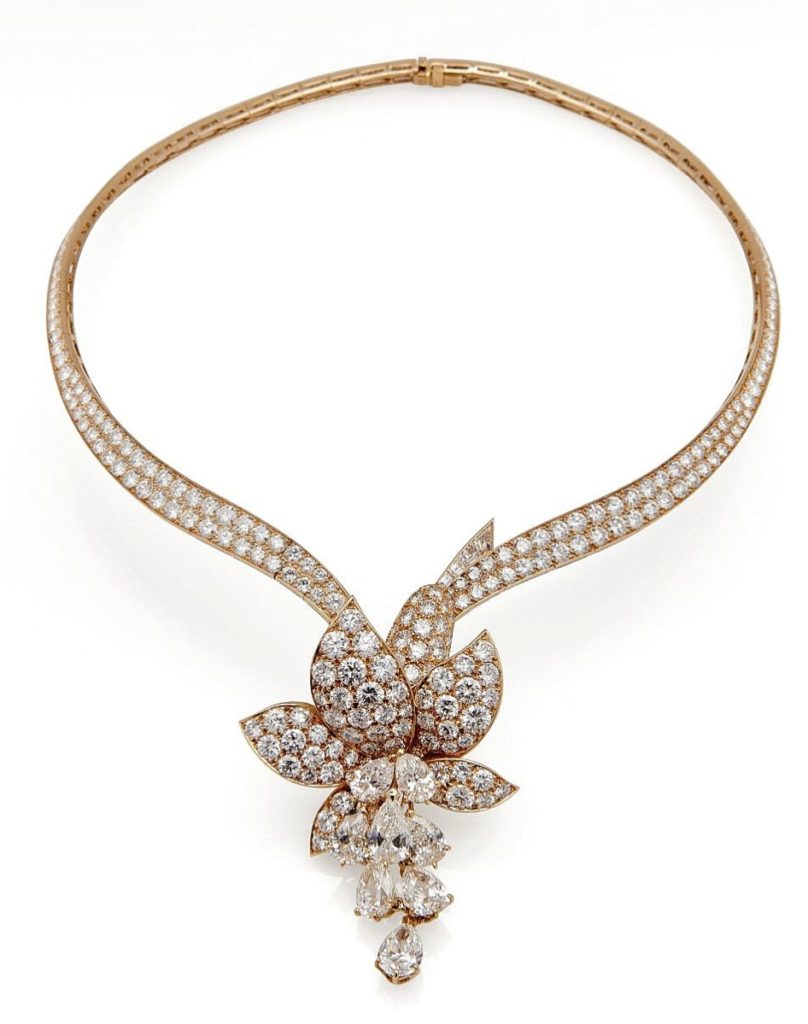
At a final price of $537,500, this signed Van Cleef & Arpels 18K gold and diamond “Fuchsia” pendant/brooch and necklace was the star of the sale. It was a custom-made piece and was accompanied by a letter discussing the commission, adapting the brooch, and a rendering of the necklace. It, and the matching earclips, were a gift to the consignor from her husband celebrating her 40th birthday.
Review and Onsite Photos by Rick Russack, Additional Photos Courtesy Grogan & Company
BOSTON – Grogan & Company’s May 1 sale continued the firm’s streak of grand-slam home-runs. Adhering to the revised scheduling, this sale had just 211 lots, only jewelry and paintings, and grossed just under $3 million. Five lots earned more than $100,000 each, four of which were jewelry, with more than 40 lots earning five-figure prices. Using these figures, the average selling price per lot was more than $13,000. Only 20 lots were passed. Estimates were conservative, and GIA documentation was available for many of the jewelry items. Online catalog descriptions are detailed and include multiple photographs of each item.
Four of the lots selling for more than $100,000 each were fine jewelry. The sale was led by a Van Cleef & Arpels 18K gold and diamond “Fuchsia” pendant/brooch and necklace, which earned $537,500, and a pair of 18K gold and diamond “Fuchsia” earclips, also by Van Cleef & Arpels, which realized $375,000. Both lots had been bought by the consignor’s husband as a gift for her 40th birthday. The fuchsia flowerhead-form pendant/brooch and the necklace were both signed, and the diamonds weighed 19.02 total carat weight. To make the brooch more versatile, the couple had commissioned Van Cleef & Arpels to design a complementary necklace, adapting the brooch to be worn alone or on the necklace. This lot was accompanied by a letter discussing the commission, adapting the brooch, and a rendering of the necklace. Taylor See, jewelry department director, noted that the necklace and brooch, being a custom design, had not been seen before by collectors, adding to the interest. The following lot, also signed, was a pair of 18K gold and diamond “Fuchsia” earclips, intended to be worn with the necklace, with diamonds weighing 15.43 total carat weight. It realized $375,000.
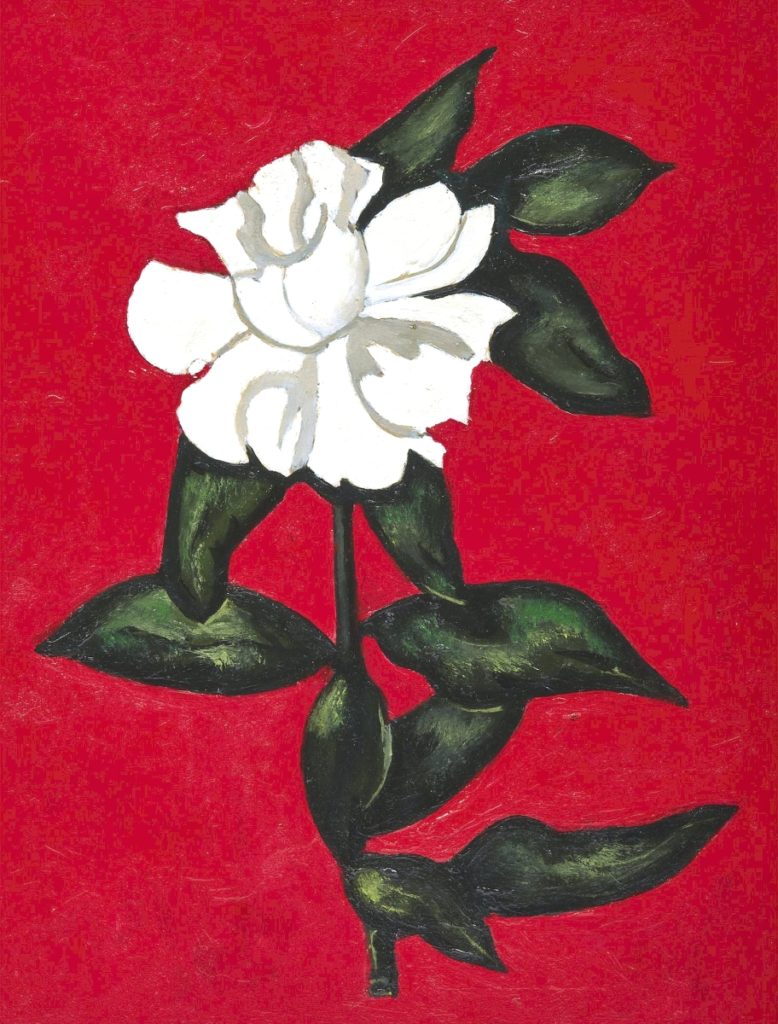
“Wild White Rose” by Marsden Hartley realized $343,750, making it the highest priced painting the sale. Aside from being a striking painting, the work had a special significance for the artist and Hartley produced several versions of the painting.
Two platinum and diamond rings also brought prices in excess of $100,000 each. One centered a round brilliant-cut diamond weighing 5.19 carats flanked by tapered baguette-cut diamonds weighing an additional 4.22 total diamond weight. The accompanying GIA report stated that the large diamond was E, VVS2, with no fluorescence. The E indicates that the diamond is colorless and the VVS2 indicates “very slightly included.” In other words, the stone in this ring was high quality and it sold for $175,000. The second ring centered a pear-shape diamond weighing 6.00 carats, flanked by trillion-cut diamonds weighing approximately 1.00 total carat weight. The GIA report for this ring indicated that the diamond was D, VVS1, with faint fluorescence, also a very fine diamond and it brought $150,000.
When, after the sale, See was asked if any of the items in her department surprised her, she mentioned a platinum, gem set and diamond “fruit cart” brooch, which reached $16,250. “It was a very well-made piece and very colorful,” she said. ” It attracted a lot of attention.” It included rubies, diamonds, emeralds and sapphires and had an undecipherable maker’s mark along with French assay marks. When, during the preview, See was asked which was her personal favorite item in the sale, she picked up a necklace of South Sea pearls with a white gold clasp set with diamonds. With 37 cultured pearls, it sold for $4,375.
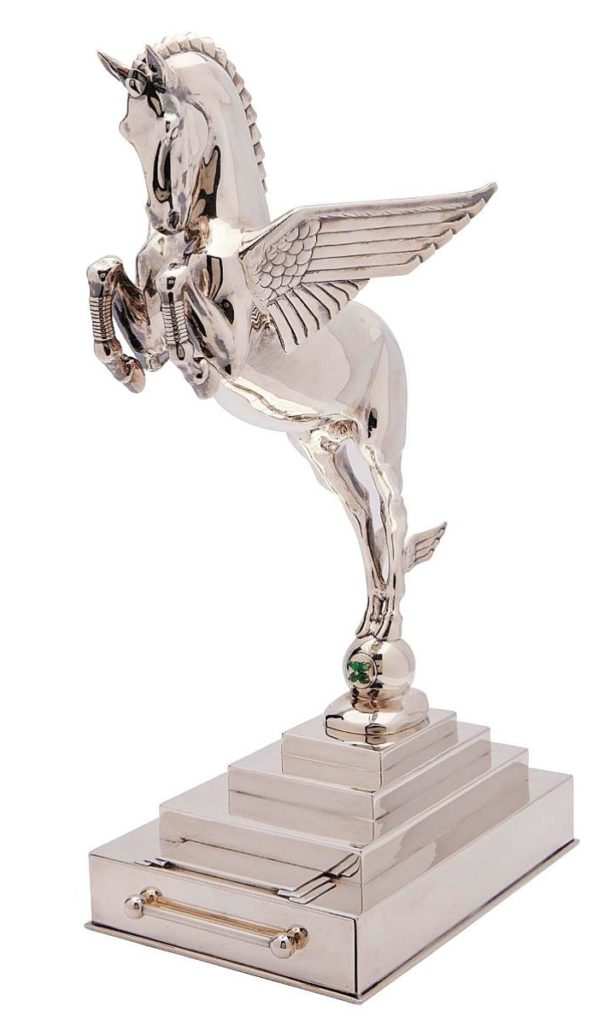
A Cartier Art Deco silver figure of Pegasus was mounted on a silver humidor. It was more than 17 inches tall, set with four emeralds centering a full-cut diamond, with a maker’s mark GT, possibly for Georges Thibault, and a French hallmark for .950 silver. It realized $31,250.
Since four of the five lots selling for six-figure prices were pieces of jewelry, the fifth was a painting, “Wild White Rose” by Marsden Hartley (1877-1943), which realized $343,750. The painting depicted a single white rose and its leaves on a vivid, dark red background. The catalog noted that this painting is included in the Marsden Hartley Legacy Project: Complete Paintings and Works on Paper. This was a significant painting to Hartley personally, as noted in the catalog. “Hartley painted ‘Wild White Rose’ in 1936. In September of that year, Hartley was living in Nova Scotia with the Mason family when both of their sons and their nephew drowned at sea. The death of his dear friends profoundly impacted Hartley, as can be seen in his repeated depiction of the iconic wild rose, or ‘rosa rugosa,’ which blooms along the Atlantic seacoast. In the ensuing years, Hartley produced many iterations of the rose to memorialize the event. The striking contrast, vivid colors, exaggerated form, bold black outlines, and flattened space of ‘Wild White Rose’ exemplify his work from this period.”
Numerous paintings earned prices in excess of $10,000, with two completely different works each earning $50,000. One was a tempera on Masonite, “Cambridge in May” by Grandma Moses (1860-1991), signed and dated 1943. It depicted a rural town scene in summer, with cultivated fields in the background, along with horse-drawn wagons, numerous houses, a large barn, etc. Most of her scenes are in winter settings, making this work a little unusual. Cambridge, N.Y., is just a few miles from her home in Eagle Bridge, N.Y. The other painting bringing the same price, $50,000, was a 1928 work by Austrian artist Rudolf Wacker (1893-1939). This painting was an example of the scenes for which he was most noted – houses and backyards in working-class neighborhoods. Another work by Wacker earned $34,375. Both had descended in the artist’s family, and both sold to buyers in Europe.
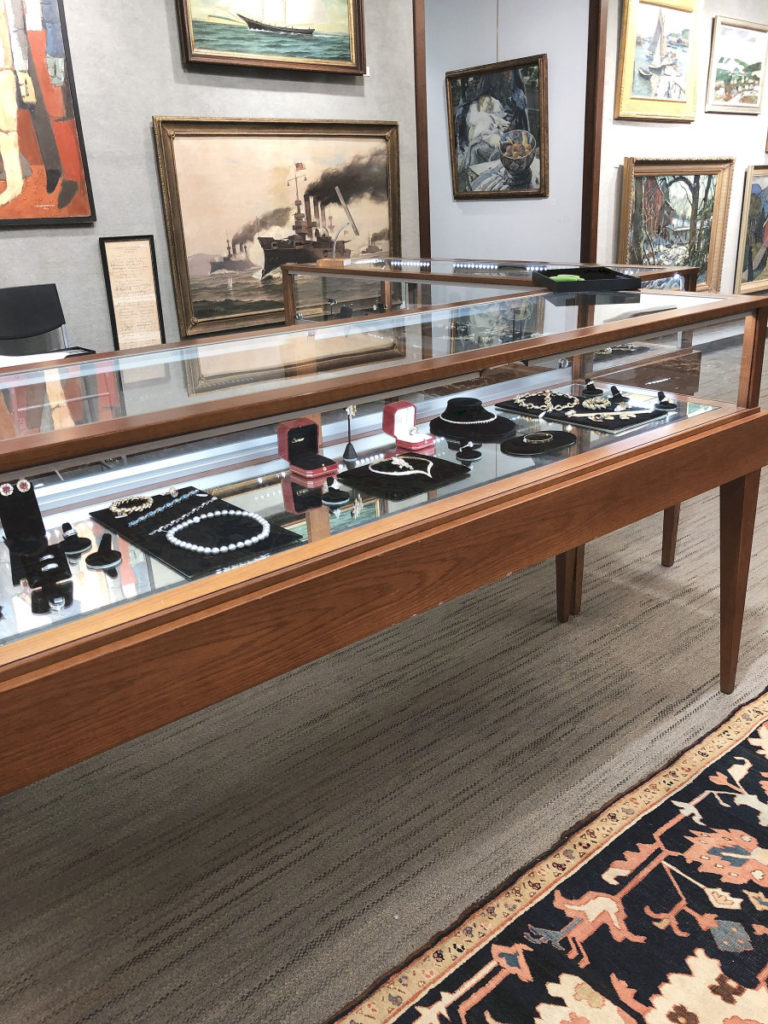
Jewelry was displayed for easy examining during the preview.
An oil on canvas, “Mountainside Road,” a rural landscape by Marguerite Thompson Zorach (1887-1968), who was a pioneer of Modernism in America, brought $25,000. Her well-known resume includes her participation in the seminal Armory Show of 1913, and she was the only woman exhibitor in the selective 1916 Forum Exhibition of Modern American Painters.
There were a number of paintings by artists of the Rockport school, the most popular of which, selling for $11,875, was Emile Albert Gruppe’s depiction of Smith Cove in Gloucester, Mass. It’s the type of harbor scene for which Gruppe (1896-1978) is well-known. Two autumn scenes by Antonio Cirino (1889-1993) were sold. One earned $2,500, and the other, a street scene at sunset with several houses, a large church and people going about their business, earned $3,438.
Georgina Winthrop, vice president and fine art director, commented that she particularly liked paintings, like the Hartley, with stories to tell. “Another one that I really liked was ‘Monhegan Burial’ by James Edward Fitzgerald (1899-1971). To me, that scene really told its own story – mourners on a rainy day, in yellow slickers moving a casket through a village street with a harbor full of boats. You could feel the emotion in that painting. And I think the price, $34,375, reflected that emotion.”
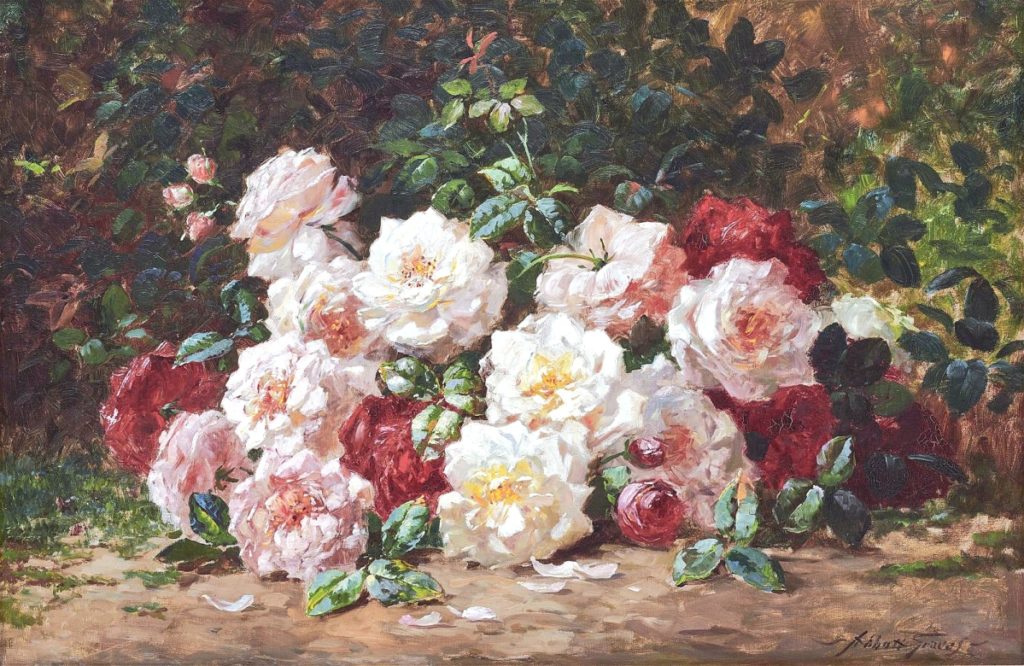
“Roses” by Abbott Fuller Graves sold for $12,500. Scenes such as this, of flowers, as well as gardens, were his favorite subject matter.
A few days after the sale, Michael Grogan said he was understandably pleased with the results. “One of the things that really caught my attention was the fact that we sent out about 145 invoices,” he said. “That indicates that most of our sales are going to individuals with very specific attraction to what they’re buying, as opposed to dealers buying multiple items for inventory. We’re being very selective in what we’re selling, and I think that our clients know they’re looking at things they may not see again any time soon. They’ve decided that it’s worth going after those select items. Sometimes that makes it tricky to accurately predict what an item will sell for.”
Prices given include the buyer’s premium as stated by the auction house. For information, www.groganco.com or 617-720-2020.





























